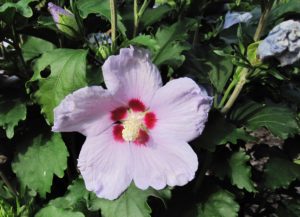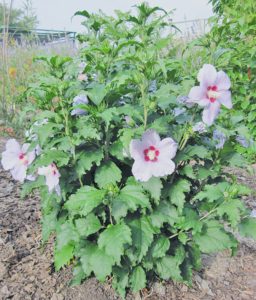White Angel, Blue Angel altheas the latest Texas Superstar releases
Two hybrid altheas have been named the latest Texas Superstars

COLLEGE STATION – Two hybrid altheas – Blue Angel and White Angel – have been named the latest Texas Superstars for characteristics that make them a top option for landscape lovers.
Blue Angel is a vigorous growing shrub to small tree with an extended blooming season featuring beautiful single blue, broadly trumpet-shaped flowers. The variety crosses Bluebird and Diane altheas.
White Angel althea combines Diane and Rose-of-Sharon shrub hibiscus and provides similar garden characteristics but features a larger final size and numerous clean white flowers.
Texas Superstar is a registered trademark owned by AgriLife Research, a state agency that is part of the Texas A&M University System. Plants are designated Texas Superstars by the Texas Superstar executive board, which is made up of nine AgriLife Research, Texas A&M AgriLife Extension Service and Texas Tech University horticulturalists.

To be designated a Texas Superstar, a plant must not only be beautiful but perform well for consumers and growers throughout the state. Texas Superstars must be easy to propagate, which should ensure the plants are not only widely available but also reasonably priced, said Dr. Mike Arnold, Texas A&M AgriLife Research landscape horticulturist, College Station.
Good choice
“There are several characteristics that make these cultivars a better choice than other altheas,” he said. “Aside from the exotic look, the flowers have unique colors. The stone blue is vibrant, and the white is a good, crisp, clear white. These are resilient plants with prolific flowering and high output over a long period of time, which makes these varieties a good choice.”
Both cultivars offer tough, versatile plants with reliable and attractive warm-season flowers, Arnold said. They grow as erect woody deciduous shrubs or small trees, and both varieties perform best in full sun or light afternoon shade, he said. Shady locations tend to reduce flower production.

Blue Angel is somewhat smaller than the typical species type, maturing at 6-8 feet after several years. Plants eventually form upright oval to vase-shaped habits with a spread equal to or often less than their height.
“The Blue Angel is more compact with a nicer, denser canopy than other altheas while the White Angel is similarly dense but larger,” Arnold said. “It’s good for in most settings, especially urban landscapes, and is a relatively foolproof variety for any homeowner.”
Both varieties can be planted as bare-root plants in early winter, or container-grown or balled-and-burlapped plants year-round, he said.
The plants need well-drained soils, Arnold said. Plants are well-adapted to a range of soil pH but may occasionally require iron chelate in very high pH soils.
These plants respond favorably to good fertility, but can persist in low to moderate fertility soils, he said. They are moderately drought tolerant and low maintenance once established.
Blue Angel and White Angel can be incorporated in landscapes as a general-purpose deciduous shrub, warm-season accent, limbed up as a small tree, or grown in large landscape containers. Flowers provide ecosystem services as pollinator and hummingbird attractants and are sometimes employed as cut flowers for floral arrangements.
Insufficient winter chilling can sometimes reduce or delay budbreak in warmer parts of Zone 9. Homeowners could experience light aphid infestations, but they can be controlled by spraying plants with a strong stream of water.
“Aphids can be a problem as with any hibiscus, but can be dealt with without pesticides,” Arnold said. “Other than that, Blue and White Angel altheas are two great choices for any landscape. The plants are tough once they are established. The flowers are vibrant and are great attractors of butterflies and other pollinators, and the varieties aren’t aggressive invasive growers so they don’t require much maintenance.”
More information about other Texas Superstar plants and a list of wholesalers and retailers who stock them can be found at http://texassuperstar.com/.





